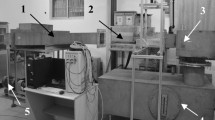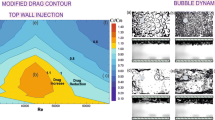Abstract
Micro-bubble is one of the most promising methods for reduction of skin friction drag. The injection of gas bubbles into a turbulent boundary layer may have multiple impacts on the turbulent flow structure. This work aims to understand the interaction between micro-bubbles and the turbulent boundary layer, especially the effect of the bubble layer thickness on the skin-friction drag reduction. Large eddy simulation was conducted for a turbulent boundary layer over a flat plate, injected with micro-bubbles, with a view to reduce skin-friction drag. The Reynolds number Re θ examined was 1430 based on the momentum thickness θ and free-stream velocity \( U_{\infty } \). A three-dimensional perturbation method was deployed to generate a turbulent boundary layer within a short distance of inflow.
Access provided by Autonomous University of Puebla. Download conference paper PDF
Similar content being viewed by others
Keywords
1 Introduction
The use of micro-bubble as a way to reduce skin friction in turbulent flows has been a focus for researchers in the expectation that which is applicable to ships. Previous experimental work has shown it can reduce the skin friction by as much as 80% [5, 7]. Ferrante and Elghobashi [2, 3] reported their direct numerical simulation study to explain the mechanisms of drag reduction in a microbubble-laden spatially developing turbulent boundary layer, and also the Reynolds effect on drag reduction. Our objective in the present paper is to further explain the interaction between micro-bubbles and the turbulent boundary layer, especially the effect of the micro-bubble layer thickness on the skin-friction drag reduction.
2 Simulation Method
It is well understood that the inner layer of the turbulent boundary layer has low speed streaks, while the outer layer has large scale coherent structures. In order to reproduce turbulent flow numerically, here we follow Sandham et al. [6] method, in which the streamwise and wall-normal fluctuations were generated with one mode in the inner region and three modes in the outer region. Disturbances in the inner region (denoted as \( \hat{u}^{\text{inner}} \)) represents lifted streaks, with a peak at a location of \( y_{p,j}^{ + } \), while the outer region disturbances (denoted as \( \hat{u}^{\text{outer}} \)) represent three-dimensional vortices. The disturbances can be written as follows:
where subscripts j = 0, 1, 2, 3 are mode indices, \( y^{+} \) is the y− coordinate in wall units and the \( c_{i,j} \) are constants. Forcing frequencies are denoted by \( \omega_{j} \), spanwise wave numbers by \( \beta_{j} \), and phase shiftes by \( \varphi_{j} \).
Figure 1 shows a schematic of the turbulent boundary flow over a flat plate. The large-eddy simulation (LES) used presently is applied to a computational domain of \( 10\delta \times 3\delta \times 3\delta \) (\( \delta \) is the turbulent boundary thickness) with a grid of 148 × 90 × 90 points, uniformly distributed in the streamwise and spanwise directions and stretched in the wall-normal direction (Fig. 1b). The grid resolution for inflow is approximately \( \Delta x^{ + } = 38 \) and \( \Delta z^{ + } = 18 \) with 10 points in the viscous sublayer (\( y_{\hbox{min} }^{ + } = 0.61 \)). Superscript + denotes normalization by wall units, e.g. \( U^{ + } = U/u_{\tau } \) and \( y^{ + } = yu_{\tau } /\upsilon \), where U is the streamwise mean velocity, \( u_{\tau } \) is the wall friction velocity and \( \upsilon \) is the kinematic viscosity of fluid. At the lower wall, a no-slip condition was used for the velocity components, and at the upper surface, a free-slip boundary condition was applied. Periodic boundary conditions were used in the spanwise direction.
Figure 2 shows the comparison for the mean streamwise velocity \( {<} {U} {>}^{+} \) and three Reynolds stresses \( {<} {u}^{'2} {>}^{+} , {<} {v}^{'2} {>}^{+} \) and \( {<} {u}^{'} {v}^{'} {>}^{+} \) at \( x = 9\delta \), where \( Re_{\theta } = 1430 \). In this paper, < > represents spatial averaging in the spanwise (z) direction in addition to time averaging of the enclosed quantity. The mean velocity profile is in good agreement with experimental profile obtained by Degraaff and Eaton at the same \( Re_{\theta } \) [1]. The difference in the magnitude of the peak of \( {<} {v}^{'2} {>}^{+} \) and \( {<} {u}^{'} {v}^{'} {>}^{+} \) is probably due to experimental uncertainty. Degraaff and Eaton [1] indicate a 10% error in the measured value of \( {<} {u}^{'} {v}^{'} {>}^{+} \). The results provide a validation for the single-phase simulation.
Then, the micro-bubbles are introduced at the inlet along with the fluid through the wall. The bubbly air-liquid flows are treated by Mixture model. The size of micro-bubble is 40 μm. Two parameters are investigated, i.e. the inlet air volume fraction \( \Phi _{v,in} \) and micro-bubble layer thickness \( h^{ + } \) (micro-bubble layer thickness along with y-direction (Fig. 1a)).
3 Results and Discussion
The effect of micro-bubbles may depend on whether the turbulent boundary layer is on the lower or upper side of the plate. This work is focused on the turbulent boundary layer over the lower side. Given \( \Phi _{v,in} = 0.1 \), the ratio \( C_{{_{f} }} /C_{f0} \) from calculation and measurement [4] are 0.855 and 0.857, respectively, where C f and C f0 are the skin-friction coefficients with and without the presence of micro-bubbles. As \( \Phi _{v,in} \) increases from 0.1 to 0.3, the average drag reduction increases from 14.5 to 48.6%. Figure 3 shows the profiles of U+, dU+/dy+ and \( {<} {u}^{'2} {>}^{+} \) for different \( \Phi _{v,in} \). The effect of the micro-bubbles is appreciable for \( y^{ + } \le 10 \). The \( {dU}^{+} /dy^{+} \) decreases significantly (Fig. 3b) with the increase in \( \Phi _{v,in} \), implying a drag reduction. The viscous layer grows gradually in thickness with an upward shift of the buffer layer, resulting from the rising bubbles which distribute themselves within the boundary layer. There is a marked decrease in \( {<} {u}^{'2} {>}^{+} \) (Fig. 3c) for \( y^{ + } \le 20 \) and the peak is shifted slightly away from the wall. It has been observed based on the instantaneous vorticity \( \omega_{x} \) contours in the (y, z) plane (now shown) that the streamwise vortical structures are dislocated from the wall due to the presence of the micro-bubbles. Furthermore, the spanwise separation between streaky structures is increased.
The effect of \( h^{+} \) on the drag reduction is investigated, in which five \( h^{+} \) values are chosen, i.e., 10, 50, 200, 560 and 850. Figure 4 shows profiles of the mean volume fraction and volume fraction gradient of micro-bubble distribution along the vertical direction at \( x = 9\delta \). We can find that the concentration of microbubbles at the near wall region becomes smaller with the increasing of micro-bubble layer thickness \( h^{ } \), which is not beneficial to drag reduction. When the micro-bubble was injected into the boundary layer, the large scale vortical structure broke into small scale structure and the vorticity also decreased (Fig. 5a, b). It has been found that, when \( h^{ + } \) is less than 560 (corresponding to the boundary layer thickness), the average volume fraction of bubbles along the x direction decreases and the ability to retain bubbles on the wall is unstable. On the other hand, for h+ = 560 and 850, the thick micro-bubble layer is rather stable; so the bubble layer that is attached to the wall, which is beneficial to drag reduction.
4 Conclusion
This study shows that the presence of micro-bubbles acts to decrease the streamwise mean velocity near the wall and to push away the streamwise vortical structures from the wall, thus producing drag reduction. The drag reduction is strongly dependent on the micro-bubble layer thickness \( h^{+} \). The result shows that the optimum micro-bubble layer thickness is \( h^{ + } = 560 \), which corresponds to the boundary layer thickness.
References
Degraaff DB, Eaton JK (2000) Reynolds-number scaling of the flat-plate turbulent boundary layer. J Fluid Mech 422:319–346
Ferrante A, Elahobashi S (2004) On the physical mechanisms of drag reduction in a spatially developing turbulent boundary layer laden with microbubbles. J Fluid Mech 503:345–355
Ferrante A, Elahobashi S (2005) Reynolds number effect on drag reduction in a microbubble-laden spatially developing turbulent boundary layer. J Fluid Mech 543:93–106
Madavan NK, Deutsch S, Merkle CL (1983) Reduction of turbulent skin friction by microbubbles. Tech Memorandum 10:1–38
Merkle CL, Deutsch S (1992) Microbubble drag reduction in liquid turbulent boundary layers. Appl Mech Rev 45(3):103–127
Sandham ND, Yao YF, Lawal AA (2003) Large-eddy simulation of transonic turbulent flow over a bump. Int J Heat Fluid Flow 24(4):584–595
Sanders WC, Winkel EW, Dowling DR, Perlin M, Ceccio SL (2006) Bubble friction drag reduction in a high Reynolds number flat plate turbulent boundary layer. J Fluid Mech 552:353–380
Acknowledgements
Financial support by Scientific Research Fund of Shenzhen Government through grant JCYJ20160531192108351 is gratefully acknowledged.
Author information
Authors and Affiliations
Corresponding author
Editor information
Editors and Affiliations
Rights and permissions
Copyright information
© 2019 Springer Nature Singapore Pte Ltd.
About this paper
Cite this paper
Cao, H.L., Guo, W., Li, X.H., Zhou, Y. (2019). Effect of Micro-bubbles on a Turbulent Boundary Layer. In: Zhou, Y., Kimura, M., Peng, G., Lucey, A., Huang, L. (eds) Fluid-Structure-Sound Interactions and Control. FSSIC 2017. Lecture Notes in Mechanical Engineering. Springer, Singapore. https://doi.org/10.1007/978-981-10-7542-1_21
Download citation
DOI: https://doi.org/10.1007/978-981-10-7542-1_21
Published:
Publisher Name: Springer, Singapore
Print ISBN: 978-981-10-7541-4
Online ISBN: 978-981-10-7542-1
eBook Packages: EngineeringEngineering (R0)









